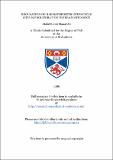Files in this item
Regulation of haematopoietic stem cycle (CFU-S) proliferation in irradiated mice
Item metadata
| dc.contributor.advisor | Riches, Andrew Clive | |
| dc.contributor.advisor | Wright, E. G. | |
| dc.contributor.author | Ali, Abdul Rabbi Manaf | |
| dc.coverage.spatial | 198 p. | en_US |
| dc.date.accessioned | 2018-06-14T13:57:56Z | |
| dc.date.available | 2018-06-14T13:57:56Z | |
| dc.date.issued | 1986 | |
| dc.identifier.uri | https://hdl.handle.net/10023/14074 | |
| dc.description.abstract | It has been suggested that the proliferation of haematopoietic stem cells (CFU-S) in mice is controlled by the balance of inhibitory and stimulatory factors. In normal mice about 10 percent of the CFU-S population are in DNA synthesis. It has been suggested that a high concentration of inhibitor blocks CFU-S from entering into DNA synthesis. Following damage by cytotoxic agents such as drugs or irradiation about 30 - 50 percent of CFU-S were in DNA synthesis and also stimulator was shown to be present. In this study the entry of CFU-S into DNA synthesis following low and sub-lethal doses of whole body X-irradiation has been studied. Furthermore the stimulator producing cells were also characterized. The number of CFU-S in bone marrow was not affected following exposure to a dose of 0.5 Gy. However the number of committed progenitors for the granulocyte/macrophage lineage was significantly reduced. The percentage of CFU-S in DNA synthesis was found to increase to 37.0+/- 7.0 percent at 30 minutes and 43.9+/-11.2 percent at 2 hours from that observed in unirradiated mice. However at 6 hours the percentage was 14.8 8.1 percent. At a sub-lethal dose of 4.5 Gy, the percentage of CFU-S in DNA synthesis increased to 34.0+/-14.0 percent at 6 hours after exposure, however before this time the percentage remained at a similar level to unirradiated control mice. When plugs of bone marrow were irradiated in-vitro at 0.5 Gy and 4.5 Gy doses, the time of CFU-S entering into DNA synthesis was the same as following in-vivo irradiation. The dose response curve of CFU-S entering into DNA synthesis when measured at 2 hours after exposure showed that the percentage was increased as the dose was increased and reached 30-50 percent at a dose of 0.5 Gy. Above this dose the CFU-S population was not stimulated at this time. When the percentage of CFU-S in DNA synthesis was measured at 6 hours after exposure, the values were the same as control for doses less than 0.5 Gy and above this dose the values were 30-50 percent. The presence of stimulator in bone marrow after irradiation was found to parallel the proliferative activity of CFU-S. The CFU-S population obtained 1 hour after 1.5 Gy was shown not' to respond to stimulator as CFU-S from normal bone marrow dia. The conditioned media prepared from bone marrow of mice Irradiated at 9.0 Gy (1 to 5 days post Irradiation) increased the proportion of CFU-S from normal bone marrow in DNA synthesis to 30-50 percent. The depletion of Thy1.2+ cells from regenerating bone marrow did not affect the ability to produce stimulator. However when Fc+ and Ia-2k+ cells were removed the stimulator production was affected. This suggests that the stimulator producing cells were radioresistant, Thy1.2-, Fc+ and Ia-2k+. | en_US |
| dc.language.iso | en | en_US |
| dc.publisher | University of St Andrews | |
| dc.subject.lcc | QH643.H2A6 | en |
| dc.subject.lcsh | Radiobiology | en |
| dc.title | Regulation of haematopoietic stem cycle (CFU-S) proliferation in irradiated mice | en_US |
| dc.type | Thesis | en_US |
| dc.contributor.sponsor | Malaysia Department of Public Service | en_US |
| dc.contributor.sponsor | Malaysia Nuclear Energy Unit | en_US |
| dc.type.qualificationlevel | Doctoral | en_US |
| dc.type.qualificationname | PhD Doctor of Philosophy | en_US |
| dc.publisher.institution | The University of St Andrews | en_US |
This item appears in the following Collection(s)
Items in the St Andrews Research Repository are protected by copyright, with all rights reserved, unless otherwise indicated.

